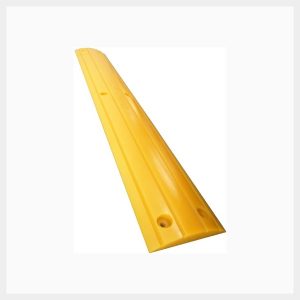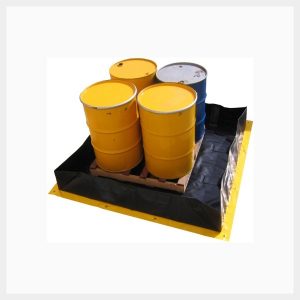Bunding is a structure around primary containers such as drums and tanks as well as machines and other sources of potential leaks to contain any spilled liquid. Bunds can be a trench or a pit but are mostly in the form of a wall surrounding the risk area.
Bunds are also commonly referred to as “secondary containment facilities”. The main application of a bund is to prevent damage caused to people, property and the environment as a result of the primary container, such as a drum, failing. When a spill is contained in the bund the cleanup can happen in a much safer and controlled manner.
Spill containment bunds are separated into two categories. Permanent bunds and portable bunds. Permanent bunds are made out of a variety of materials including concrete, masonry, metal and polyurethane. Read More
Portable bunding is used in temporary, transit and “in the field” storage aplications and are commonly made from polyethylene or a variety of geomembranes.
The material is selected depending on the compatability with the liquid stored.
Standards Australia publishes a standard for the storage and handling of each class of chemical. These standards include:
AS 1940-2017 The storage and handling of flammable and combustible liquids
AS 4326-1995 The storage and handling of oxidising agents
AS 3780-1994 The storage and handling of corrosive substances
AS 2507-1984 The storage and handling of pesticides
AS/NZS 4452-1997 The storage and handling of toxic substances
Each of these standards clearly describes the requirement for bund size and construction. Guidance for bund construction can also be found on the EPA Victoria website.
The common rule of thumb applied to bunding is that it must be impervious to the substance stored and be able to contain the greater of 110% of the contents of the largest single container or 25% of the total stored in the bund.
Although bunding requirements may vary based on drainage and the level of risk, NSW EPA states that the following sites require compliant bunding:
- any locations where spills are common, including transfer points, workshops, factories, service stations, buildings or pieces of machinery, wash bays, and other areas in which a material is transferred from its container.
- chemical storage facilities
- pesticide storage facilities
- petroleum storage facilities
- electrical transformers containing oil and/or PCBs
- facilities used to transfer stored liquids (such as transport facilities)
- drum storage areas, either temporary or permanent
- processing areas
- any other facilities that store substances other than water or uncontaminated stormwater. For example, milk (because of its high biological oxygen demand and solubility) can cause more environmental damage than oil (which floats on water and is removed relatively easily), so bunding might be required.
If you are in doubt of the bunding required to ensure you meet you legal obligations you should consult with an accredited independent dangerous goods consultant. For more information contact the Australian Institute of Dangerous Goods Consultants.
Bunding is a secondary containment solution that catches spills and leaks from the main containment system, like a drum. Any liquid that escapes the main containment system will be caught within the bunding, and therefore prevented from spilling into the workplace. Bunding is made of an impermeable floor and walls that form a watertight area around the primary storage containers.
If you then you require bunding. This could take the form of a simple spill tray or a purpose built facility to contain 1,000,000 litres.have containers of chemicals that could create a hazard to people or the environment in the event of a spill
The two main categories of bund are permanent bund and portable bund.
A permanent bund is attached to the ground and is commonly found around permanent tanks, around pallet racking or across doorways. They are usually made of concrete and masonry. Polturethane is an effective material used for bunding across doorways or other areas requiring vehicle and forklift access.
A portable bund is commonly made from rigid polyethylene or from a geomembrane fabric. These types of bunds are used in transit, production and process areas. The collapsible bunds are usually seen in field applications due to their lightweight and flexible features.
The capacity of a bund is determined by the the volume of liquid stored and the size & quantities of the containers stored. The various Australian Standards for the storage and handling of the different classes of chemicals all contain information regarding bunding.
There are some variations in the standards but the rule of thumb applied is the the bund must be large enough to contain the greater of:
110% of the largest container in the bund
or
25% of the total stored in the bund
In order to maintain a compliant capacity in the bund, it must be kept free of superfluous items and any pooled liquids must be cleaned up and removed immediately.
With almost 40 years of helping Australian companies to operate safety. Spill Station Australia is able to share a wealth of knowledge and experience.
Standard Australia publish a range of standards for the storage and handling of all classes of chemicals. Below is a list of standards that all includes details on bunds suitable for each specific class.
AS 1940-2017 The storage and handling of flammable and combustible liquids
AS 4326-1995 The storage and handling of oxidising agents
AS 3780-2008 The storage and handling of corrosive substances
AS/NZS 4452:1997 The storage and handling of toxic substances
Each of these standards clearly describes the requirement for bund size and construction. You can purchase a copy of these standards from https://infostore.saiglobal.com/en-au/
EPA Victoria publish excellent guidance for bund construction that can be found on the EPA Victoria website.
If you are still unsure how to proceed you can engaged an accredited dangerous goods consultant to provide you with definitive advice. A list of consultants can be found on the Australian Institute of Dangerous Goods Consultants (AIDGC) website.
The size of bunding that you will require will depend on the volume of your primary storage containers and the amount of liquid present. In Australia, the requirements are that bunding capacity must be at least 110% of the largest container or 25% of the total stored on the bund - whichever is greater.
The type of bunding that your workplace requires will depend on a number of factors including the type of liquids you use, how much liquid is on-site, whether or not you need portable bunding, and the length of time you will have liquids in storage. You should also consider your work environment and the risk that any spills or leaks would have on the environment, animals and people in and around your worksite. Before handling or storing any hazardous liquids on site, it is essential that you conduct a thorough risk assessment and that you do all of your due diligence to ensure you’re meeting Australian WHS regulations.
To be compliant, bunding needs to be impervious (it needs to be sturdy enough to contain chemicals without leakage), chemically resistant (made of materials that will not react, rust or corrode when met with chemicals), fire-resistant (made from non-combustible material) and capable of recovering chemicals (must allow spills to be removed and disposed of safely).
The requirement for bunding should be established on a site-to-site basis. There are all sorts of facilities that have bunded areas, including storage facilities, drum storage areas, processing areas, breweries, milk processing plants and generally all facilities that are used to transfer or store liquids. Bunding is very common in factories, workshops, wash bays, service stations and transfer points. Different work sites have different requirements in terms of spill containment and bunding (they may require portable bunding, collapsible bunding or more permanent bunding solutions). The spill containment and/or bunding that your workplace will require will depend on your industry, the type of liquids you have on-site and the volume of said liquids.
If you have any other questions about our bunding solutions, don’t hesitate to contact us. We have all sorts of secondary containment options available to suit all needs and are happy to help in any way we can to keep your workplace safe and compliant.


